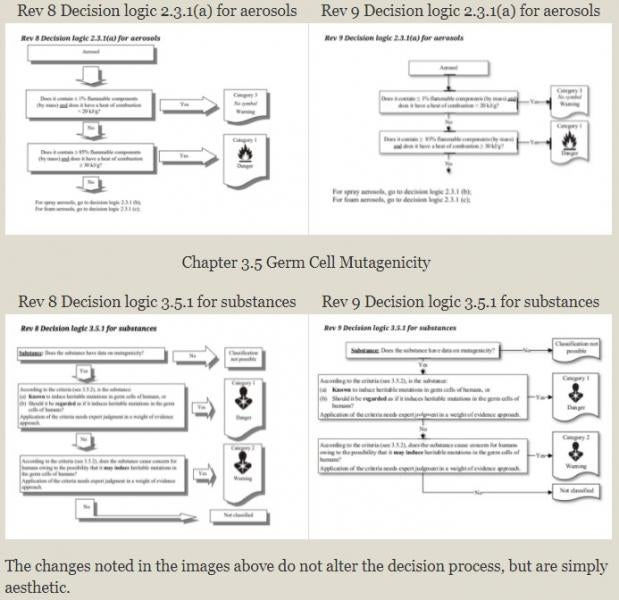On September 14, 2021, the United Nations (UN) published an electronic version of the ninth revised edition (Rev 9) of the Globally Harmonized System of Classification and Labeling of Chemicals (GHS) available for free for consultation purposes. The amendments to the eighth revision of the GHS (Rev 8) include extensive revision of Chapter 2.1 (explosives) to address explosion hazard determination better when explosives are not in transit; the revision of decision logic; the revision of the classification and labeling summary tables in Annex 1; the revision and further rationalization of precautionary statements; and the updating of references to Organization for Economic Cooperation and Development (OECD) test guidelines for the testing of chemicals in Annexes 9 and 10. In addition, several format changes to decision logic are noted throughout. The decision logic provides clarification on the process for how to arrive at the appropriate classification.
The revisions to Chapter 2.1 (explosives) include the following new subchapters:
-
Subchapter 2.1.1.2.2 covers the substances and mixtures that are specifically excluded from the class of explosives. This includes ammonium nitrate-based emulsions, suspensions, or gels that meet certain criteria; substances and mixtures that meet the criteria for classification as desensitized explosives; and substances and mixtures that have not been manufactured with a view to producing, in themselves, an explosive or pyrotechnic effect and that meet certain criteria.
-
Subchapter 2.1.1.3 covers other considerations, including the relation to the classification according to the UN Model Regulations; the configuration dependence of the division; the hierarchy of the categories; change of classification over the life cycle; and exclusions from the hazard class.
Table 2.1.1 on the criteria for explosives now includes two categories, and Category 2 includes three subcategories
|
Category |
Subcategory |
Criteria |
|
1 |
|
Explosive substances, mixtures, and articles that:
or
|
|
2 |
2A |
Explosive substances, mixtures, and articles that have been assigned:
|
|
2B |
Explosive substances, mixtures, and articles that have been assigned Division 1.4 and a compatibility group other than S and which:
|
|
|
2C |
Explosive substances, mixtures, and articles that have been assigned Division 1.4 compatibility group S and that:
|
Table 2.1.2, “Label elements for explosives,” has been revised to provide label elements based on the above categories. Subchapter 2.1.4.1, “Decision logics,” now includes Decision logic 2.1(a) for categories of explosives and Decision logic 2.1(b) for subcategories of explosives. Annex 1, Classification and Labeling Summary Tables, has also been revised. The revisions include changes made to reflect the revisions made to Chapter 2.1 (explosives).
Examples below provide images showing a few of the format revisions to decision logic explanations noted throughout Rev 9.
Chapter 2.3 Aerosols and Chemicals under Pressure

Commentary
The UN model is adopted by countries in several different ways. Some countries choose to adopt all the building blocks (physical, health, and environmental hazard classes and categories) “as is” into their legislation. The revised edition adopted will determine the details implemented into the legislative framework. Some countries adopt the criteria-based approach of the UN model, but exclude certain building blocks (excluding either an entire hazard class or just certain categories within the hazard class). A criteria-based approach allows the ability to self-evaluate the hazards, based on the criteria, to determine the classification. Other countries have chosen to adopt the basic UN model, but modify it to fit within their existing legislation or regulatory framework. This often results in a merging of regulations where the country may choose to retain existing schemes (e.g., required substance classifications or lists of classifications for specific substances) and elements of self-classification based somewhat on the UN criteria. The edition a country adopts is often based on the most current version available at the UN at that time. As there are currently 72 countries listed on the UN GHS site that are in the process of adopting or have adopted the GHS standards, the publication of Rev 9 is expected to generate activities within those countries on how best to address the current version.
As noted in our February 16, 2021, memorandum and The Acta Group’s (Acta®) Global Regulatory Update for January 2021, the United States and Canada have both proposed updates to their current hazard communication regulations to align them with Rev 7 and some aspects of Rev 8. Most trading partners are aligned or proposing to align with Rev 7. The expectation is that it could take several years before any country opts to adopt Rev 9. Anyone offering or attempting to characterize explosives may find the guidance and updates in Rev 9 extremely beneficial, but should consider the country in which the products are provided before utilizing the classification scheme, as it will not align with the regulatory obligations of countries that are proposing or are currently aligned with Rev 7 of UN GHS.


 />i
/>i

